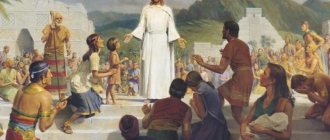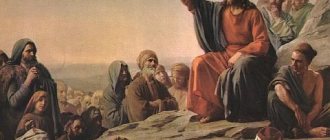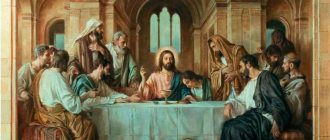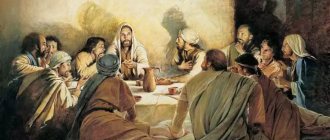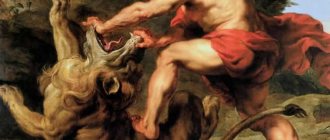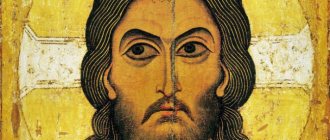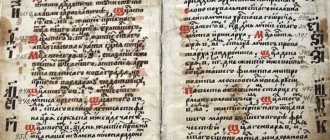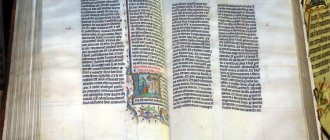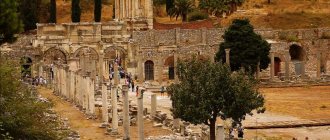Prehistory and early life
Much of Jesus' life is told through the four Gospels of the New Testament Bible, known as the canonical Gospels, written by Matthew, Mark, Luke and John. These are not biographies in the modern sense, but allegorical stories. They are written to engender faith in Jesus as the Messiah and the incarnation of God who came to teach, suffer and die for the sins of people.
Jesus was born around 1 AD. e. in Bethlehem. His mother, Mary, was a virgin engaged to Joseph the carpenter. Christians believe that the virgin birth occurred. Its origins can be traced back to the house of David. According to the Gospel of Matthew (2:1), Jesus was born during the reign of Herod the Great, who, upon hearing of the birth of a baby, felt threatened and attempted to kill Jesus and with him all the male children of the city of Bethlehem under the age of two. But Joseph was warned by an angel and took Mary and the child, the family fled to Egypt and lived there until the death of Herod, after which they returned and settled in the city of Nazareth, in Galilee.
Very little is known about the early life of Jesus. The Gospel of Luke (2:41-52) tells that 12-year-old Jesus accompanied his parents on a pilgrimage to Jerusalem. A few days later he was found in the temple, where he was discussing matters of faith with the elders of Jerusalem. There are traces of references in the New Testament to Jesus working as a carpenter at this time. It is believed that he began his ministry at the age of 30, when he was baptized by John the Baptist in the Jordan River, who, upon seeing Jesus, proclaimed him the Son of God.
The appearance of Christ raises many questions. It is believed that he was a man of pleasant appearance, with brown hair, a beard of the same color, and brown eyes. However, there is no exact information about what Christ looked like.
After his baptism, Jesus went to the Judean desert to fast and meditate for 40 days and nights. The temptation of Christ is described in the Gospels of Matthew, Mark and Luke. The devil appeared and tempted Jesus three times, once to turn a stone into bread, another time to throw himself off a mountain where angels would rescue him, and a third time to offer him all the kingdoms of the world. All three times Jesus rejected the temptation of the devil and drove him away.
Jesus returned to Galilee and made trips to neighboring villages. During this time, several people became his students. One of them was Mary Magdalene, who was first mentioned in Luke 16:9 and then in all four Gospels at the crucifixion. Although she is not mentioned in the context of the 12 Disciples, she is believed to have been involved in Jesus' ministry from the beginning until his death and beyond. According to the Gospels of Mark and John, Jesus appeared to Magdalene first after His resurrection. According to the Gospel of John (2:1-11), when Jesus began his ministry, he and his disciples went with Christ's mother, Mary, to a wedding in Cana in Galilee. Suddenly the wedding ran out of wine, and Jesus’ mother came to him for help. At first Jesus refused to intervene, but then he relented and asked the servant to bring him large jars of water. He turned water into wine, and this event better than ever demonstrates the faith of his disciples in him.
The Gospels tell the story of Jesus as he traveled through Judea and Galilee, using parables and miracles to explain how prophecies were fulfilled and that the Kingdom of God was at hand. As Jesus' teachings spread and he healed the sick and sick, more people began to follow him. As Jesus continued to preach about the Kingdom of God, crowds of people grew larger and larger and began to proclaim him as the messiah.
Near the city of Caesarea, Jesus talked with his disciples. According to the Gospels of Matthew (16:13), Mark (8:27) and Luke (9:18), he asked, “Who do you say I am? The question confused them, and only Peter answered: “You are the Christ, the Son of the living God. “Jesus blessed Peter by taking the titles “Christ” and “Son of God” and declared the proclamation to be a divine revelation from God. Jesus then proclaimed Peter as the leader of the church, warned his disciples of the conspiracy against him and his destiny to suffer and be killed, only to rise from the dead on the third day.
Less than a week later, Jesus took three of his disciples to a high mountain where they could pray alone. According to legend, Jesus' face began to shine like the sun, and his entire body glowed with white light. Then the prophets Elijah and Moses appeared, and Jesus spoke to them. A bright cloud appeared around them, and a voice said: “This is my beloved son, with whom I am well pleased; listen to him.” This event, known as the “Transfiguration,” is a turning point in Christian theology. It supports the identity of Jesus as the Christ, the Son of the living God.
Jesus arrived in Jerusalem a week before the Passover holiday riding on a donkey. Many people took palm branches and greeted him at the entrance to the city. They praised him as the son of David and as the Son of God. The priests and Pharisees (one of the religious movements in Judea), fearing the growing public adoration, felt that it had to be stopped. All four Gospels describe Jesus' last week in Jerusalem. During this time, Jesus raised Lazarus from the dead, confronted the money changers and merchants in the temple, and argued with the chief priests who questioned Jesus' authority. He told his disciples about the coming days and that the Jerusalem temple would be destroyed. Meanwhile, the priests and elders met with the high priest Caiaphas and began planning to arrest Jesus. One of the disciples, Judas, met with the chief priests and told them how he would betray Jesus to them. They agreed to pay him 30 silver coins.
And yet, why are the two stories about Christmas so different?
There is room for different versions here. But we can assume that the Apostle Matthew, who most likely wrote his Gospel first, wanted to highlight, first of all, points that were especially significant for the readers he was targeting - the Jews. Therefore, he focused not on Christmas itself, but on the origin of the Savior from King David; at the appearance of the Magi, who learned about the birth of the King of the Jews; and on other similar things.
Luke, who wrote later and probably had the Gospel of Matthew before his eyes, tried to supplement his story with what he heard from the Mother of God.
last supper
Jesus and his 12 disciples met at the Passover meal and he gave them his last words of Faith. He also predicted his betrayal by one of his disciples and personally informed Judas that it was him. Jesus told Peter that before the rooster crowed the next morning, he would have denied knowing Jesus three times. At the end of the meal, Jesus instituted the Eucharist, which in the Christian religion signifies the covenant between God and people.
After the Last Supper, Jesus and his disciples went to the Garden of Gethsemane to pray. Jesus asked God if this cup (his suffering and death) could pass him by. He begged a group of his disciples to pray with him, but they continued to fall asleep. Then Judas came, kissed Jesus on the cheek to identify him, and the soldiers arrested him. One of the students tried to resist arrest, swung his sword and cut off the ear of one of the soldiers. But Jesus admonished him and healed the soldier’s wound.
After his arrest, many students went into hiding. Jesus was taken to the high priest and interrogated. Meanwhile, Peter followed Jesus to the court of the high priests. As he hid in the shadows, three servants asked if he was one of Jesus' disciples, and each time he denied it. After each denial, the rooster crowed. Jesus was then taken out of the house and looked straight at Peter. Peter remembered how Jesus told him that he would deny him, and he wept bitterly. Judas, watching from afar, was distraught over the betrayal of Christ and tried to return the 30 pieces of silver. But nothing could be returned. He threw coins into the temple and then hanged himself.
Songs
On this holiday, joyful music is heard in many homes. What songs can you listen to with your children about Christmas:
- “Christmas Tree” (show group “Smile”);
- "Silent Night" (Christmas hymn);
- Silent Night (Silent night in English);
- “New Star” (author Yu. Verizhnikov);
- “The Nativity of Christ” (P. Sinyavsky);
- Angels We Have Heard on High.
Crucifixion
The next day, Jesus was brought before Pontius Pilate, the Roman governor of Judea. The priests accused Jesus of claiming to be king of the Jews and asked that he be sentenced to death. Pilate first tried to hand Jesus over to King Herod, but it failed, and Pilate told the Jewish priests that he could not find any guilt in Jesus. The priests reminded him that anyone who claims to be king is against Caesar. Pilate publicly washed his hands of responsibility, but ordered his crucification in response to the demands of the crowd. Roman soldiers put a crown of thorns on his head and led him to Golgotha.
Jesus was crucified with two thieves on his left and right. Over his head was a charge against him: Jesus of Nazareth, King of the Jews. At his feet stood his mother Mary and Mary Magdalene. While Jesus was on the cross, the sky darkened, and immediately after his death an earthquake occurred, tearing the veil of the temple from top to bottom. The soldier confirmed his death by stabbing him in the side with a spear. A few hours later He was taken down from the cross and buried in a nearby tomb.
Movies
There are several cartoons and films that tell children in detail about the Nativity of Christ. Recommended list for viewing:
- My First Bible: Christmas (1995);
- “Christmas” (M. Aldashin);
- “Christmas” (Channel One documentary);
- "Guiding Star" (2017);
- “Divine Birth” (K. Hardwick);
- “Yuletide Stories” (series of Orthodox cartoons).
Also during the holidays, it will be interesting to watch films imbued with the spirit of magic: “Morozko”, “New Year’s Adventures of Masha and Vitya”, “The Snow Queen”, “Twelve Months”. Older children and adults may enjoy Hollywood films from the 1940s and 1950s: Miracle on 34th Street and The Bishop's Wife. The films “The Polar Express” and “The Angel Next Door” are worthy of attention.
Also on Orthodox Christmas they show performances called nativity scenes. The story of Jesus Christ is told and shown by dolls in a large two-tiered box. On the upper floor the worship of the baby in the manger takes place, on the lower floor there are episodes with Herod. The dolls move along the slots, and the nativity scene operator controls them.
Risen from the Dead
Three days after his death, the tomb of Jesus Christ was found empty. He rose from the dead and appeared first to Mary Magdalene and then to his mother Mary. They both informed the disciples who were hiding and later Jesus appeared to them and told them not to be afraid. During this short time, he implored his disciples to go into the world and preach the Gospel to all mankind. After 40 days, Jesus led his disciples to the Mount of Olives, east of Jerusalem. Jesus spoke his last words to them, saying that they would receive the power of the Holy Spirit before he was lifted up on a cloud and carried into heaven.
Poems about Christmas
The evening before Christmas is called Christmas Eve. Traditionally, dinner requires a 12-course table. The most important of them is kutia, the true food of God. Festive porridge is prepared from wheat, poppy seeds, nuts, raisins and honey.
When the first star appears, the fun begins. Children recite poems and sing songs.
Famous works about Christmas:
- “God sent a little angel to earth on Christmas Eve” (F. M. Dostoevsky);
- “There are countries” (S. Nadson);
- “Evening Angel” (I. Bunin);
- “Christmas Star” (B. Pasternak);
- “The Appearance of an Angel to the Shepherds” (A. Fet).
It will be useful not only to read, but also to learn a short verse with your child:
“Here comes Christmas again - the triumph of the heavenly powers: On this day Christ came to save our world from evil.
Eternal glory to Him, the Conqueror of darkness. We congratulate you with all our hearts on this great joy.”
On the evening of January 6, it is also customary for the Slavs to go caroling - recite poems and sing songs (carols), wishing prosperity to the owners of the house. Initially, they are not associated with Christian Christmas. But gradually the traditions became mixed. Today, with the appearance of the first star in the sky, young people go from house to house and recite poems of a similar nature:
“We carol, we carol,
We alternate songs and dances!
And squatted, and around,
Treat me to a pie!”
In return, hospitable hosts give children sweets and coins.
Books
Many books talk about Christmas. First of all, it is worth reading the Children's Bible with your children. Several other books are also dedicated to him:
- “Christmas book for children” (edited by T. Strygina, Nikeya publishing house, 2014)
- "Bear" (Marie Colmon);
- “The Nativity of Christ” (E. Trostnikova).
The following books will also help you immerse yourself in the atmosphere and learn more about the holiday: “Christmas Stories” by Charles Dickens, “The Little Match Girl” and “The Snow Queen” by Andersen, “Nikita’s Childhood” and “Childhood” by L.N. Tolstoy, “Eugene Onegin” by A. S. Pushkin.
Shepherds worship the newborn Son of God. The Magi approach Baby Jesus
At night, in a field outside the city of Bethlehem, shepherds sat around a fire, guarding their flock. Suddenly, an unearthly light shone before them, brighter than the flame, and in this radiance the Angel of the Lord appeared. The shepherds were so frightened that they fell to the ground out of fear and covered themselves with their hands and cloaks.
- Do not be afraid! - the Angel told them. “The Lord sent me to inform you of great joy for all people.” On this night, the Savior of the human race, the Lord Jesus Christ, was born in the city of David. Here is an indication for you: in a cave near the city you will find a swaddled Baby lying in a cattle feeder.
While the Angel was saying this, the radiance around him became brighter. The light rose up, illuminating the sky, and the shepherds saw countless other Angels there. The heavenly angelic army glorified God with sweet-sounding singing: “Glory to God in the highest, on earth peace and good will toward men.”
Finally, God's messenger disappeared and the heavenly vision disappeared. When the shepherds recovered from their fear, they got up and went to look for a cave to worship the Child.
That night, Mary really gave birth to a Son - God gave Her and all people great joy. The baby Jesus was born in a cave, in a cattle shed - as a simple man. His mother wrapped Him in swaddling clothes and laid Him on hay in a manger, that is, in a trough from which cows usually ate. The child smiled quietly, and Joseph and Mary admired, looking at Him.
Suddenly, shepherds entered the cave. They looked at the Child and fell to their knees. In joyful emotion, the shepherds bowed to the ground to the born Lord.
At the same time, three more people were rushing to the newborn Son of God. These were sages from a distant eastern country. They had great knowledge, which they received from books. The sages learned about the world by exploring nature and watching the stars. People called them magi, that is, wizards, magicians, because they told fortunes and predicted by the stars.
One of the Magi - Melchior - was already a gray-haired old man. The other - with blond curls, beardless and rosy-cheeked - is the young man Kaspar. The third was named Balthazar. He was a middle-aged man, black-haired, thin and very dark.
By studying the movement of the stars, the Magi learned the fate of people and the world. And then one day a new, very large and bright star appeared in the eastern sky. The sages were amazed and began to look in books for what this could mean. It turned out that such an unusual star indicates the birth of the greatest man, the King of the Jews.
“If at the birth of this Man,” the Magi reasoned, “a new, unprecedented star appeared, then He is truly great in the eyes of God.” Or maybe this one who was born is God Himself. We should go to Him with gifts and worship Him.
The wise men already knew that the King of the Jews was to be born in Judea, and the main city of Judea was Jerusalem. Therefore, quickly getting ready for the journey, the Magi went there.
“In Judea we will certainly find out in which city this Great King was born,” they said to each other.
Biography of Jesus Christ
Jesus Christ is the central figure in the Christian faith. For Christians, this person is the King of the world, one of the hypostases of God, the Savior who appeared in the flesh and atoned for the sins of people.
Image of Jesus Christ
The Bible says that he was a perfect, sinless, immaculately conceived God-man, a miracle worker, a healer, the head of the Kingdom of God he created, the Church, the founder and main character of a religious cult, who died, was crucified on the cross, and then resurrected. At the end of time, he will return to judge the world, after which all the saved will live and rejoice on Earth forever.
His life path and purpose are set out in the Gospels. In Islam he is recognized as a prophet, one of the messengers of Allah, in Judaism he is referred to as the False Messiah (since in the holy book of the Torah, one of the signs of the coming of the true Messiah is the end of all wars, the disappearance of evil and crime).
Who is Herod
Bethlehem of Judea is an ancient town located about an hour and a half walk from Jerusalem, and in ancient times served as a transit point for travel to Egypt.
Its first inhabitants were Canaanites, later they were replaced by Jews who came to these fertile places. Surrounded on all sides by green hills, it was conducive to relaxation and peace.
It was Bethlehem that the highest heavenly powers chose as the place for the birth of Jesus Christ, the God-man who was to transform the world.
It was above Bethlehem that a star lit up, which the three wise men saw and understood this sign as the appearance of the Savior on earth.
Meanwhile, the soldiers sent by Herod to Bethlehem began their bloody crime. They took babies under two years old from their mothers and, despite tears and pleas, killed them in public.
These were the first sufferers who shed their blood for Christ.
After this, Herod calmed down; he was sure that his successor had been killed and no one else would encroach on the royal throne. He was very wrong.
Massacre of the innocents. Artist Giotto
Believers, like a number of many secular scientists, are convinced of the reality of the existence of Jesus Christ, born of an earthly woman and embodying human and divine essence.
Proof of this, in addition to the New Testament, are many written sources of ancient philosophers and historians that have survived to our time. Let's not enter into a discussion.
It is known from the New Testament that with his preaching Jesus attracted dozens, then hundreds of people who followed him and were ready to sacrifice themselves for his faith.
Today Christianity is practiced by over two billion people on earth. In addition to moral sermons, Jesus Christ made several more predictions, some of which have come true, others are waiting in the wings.
